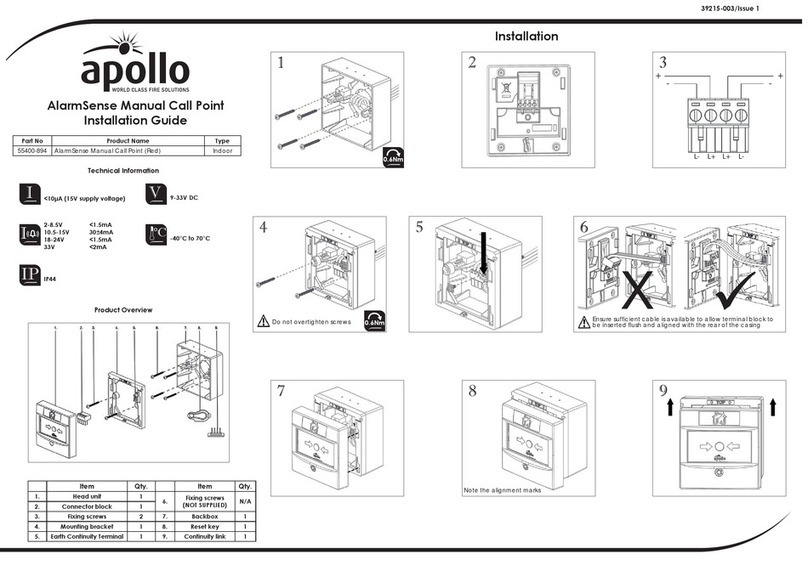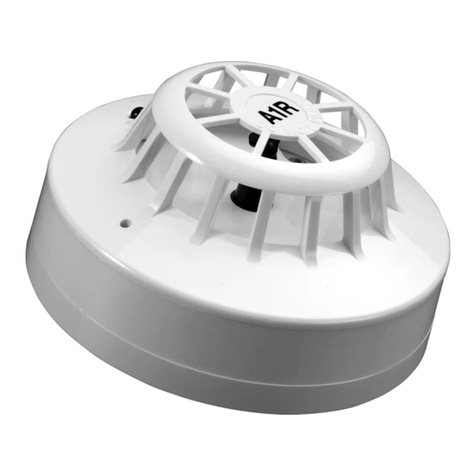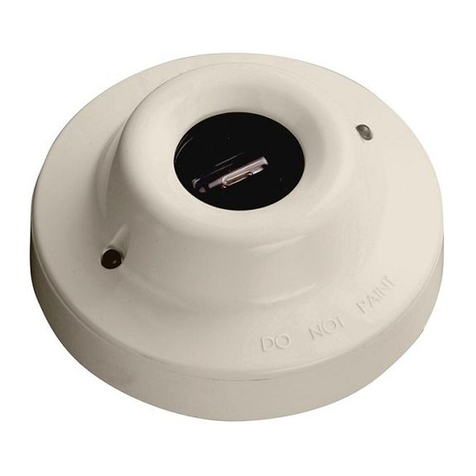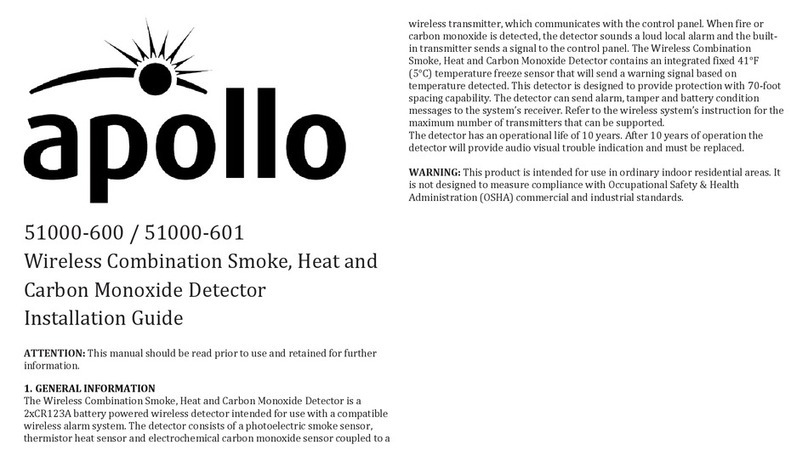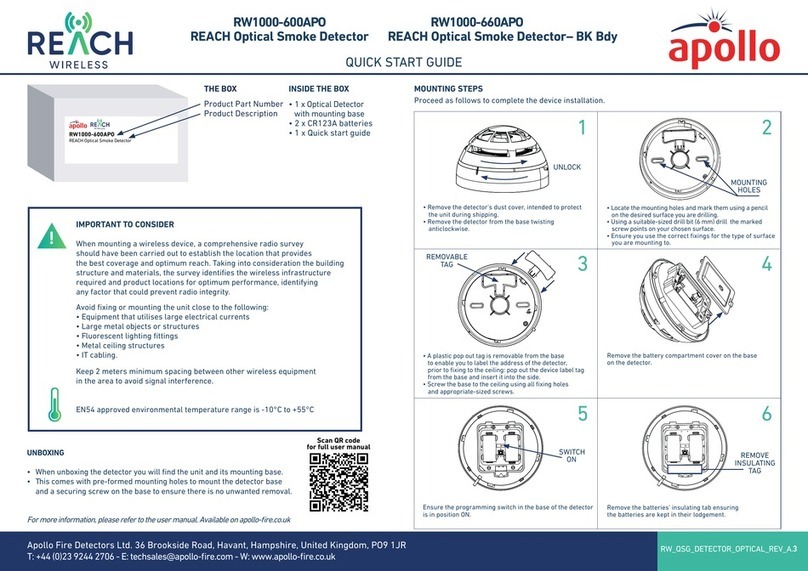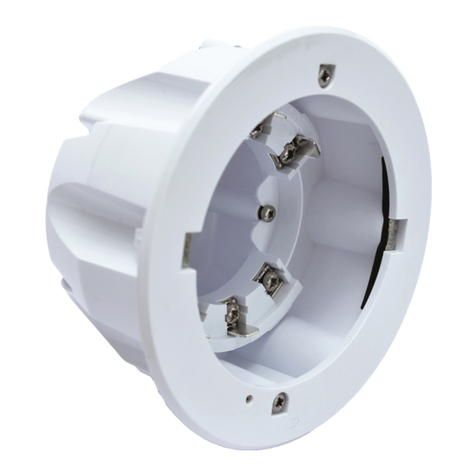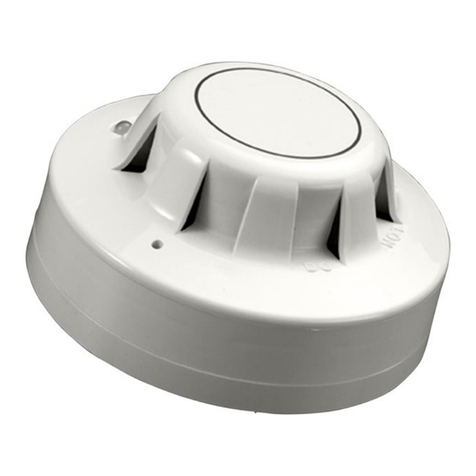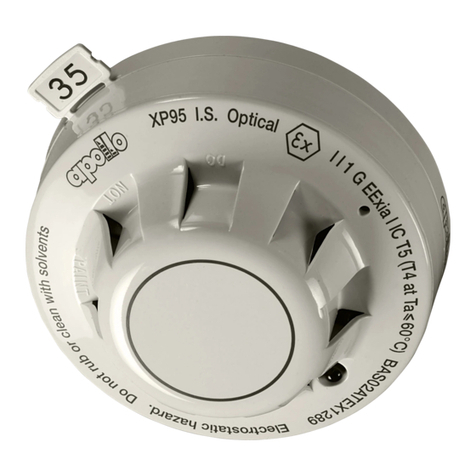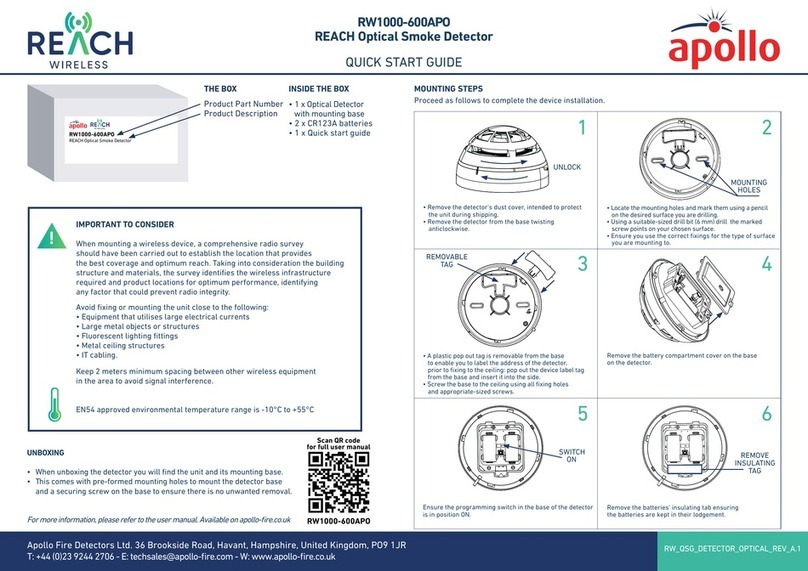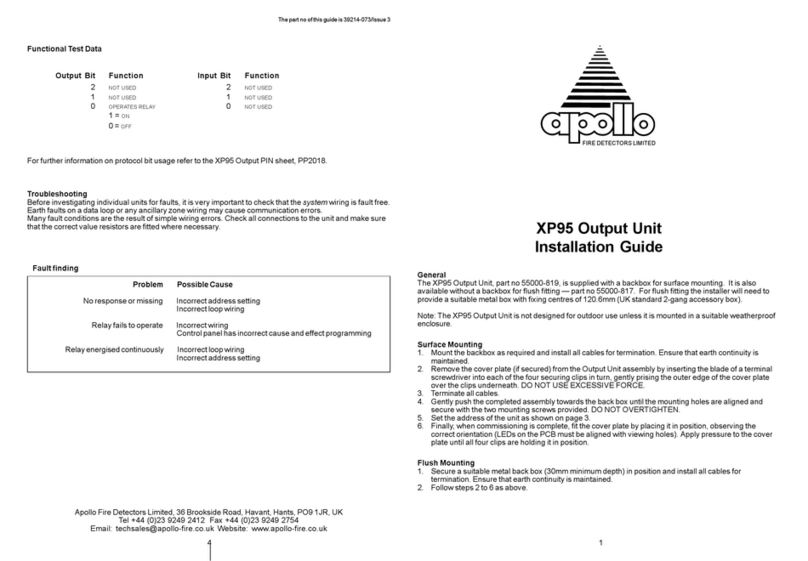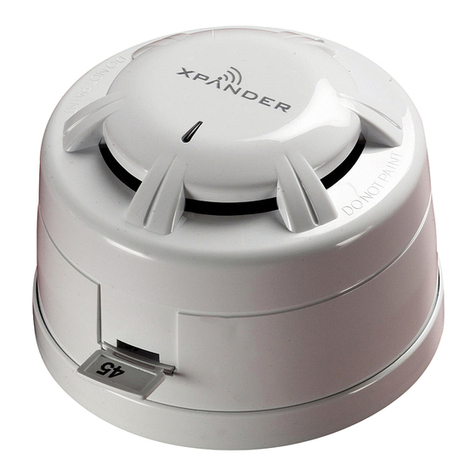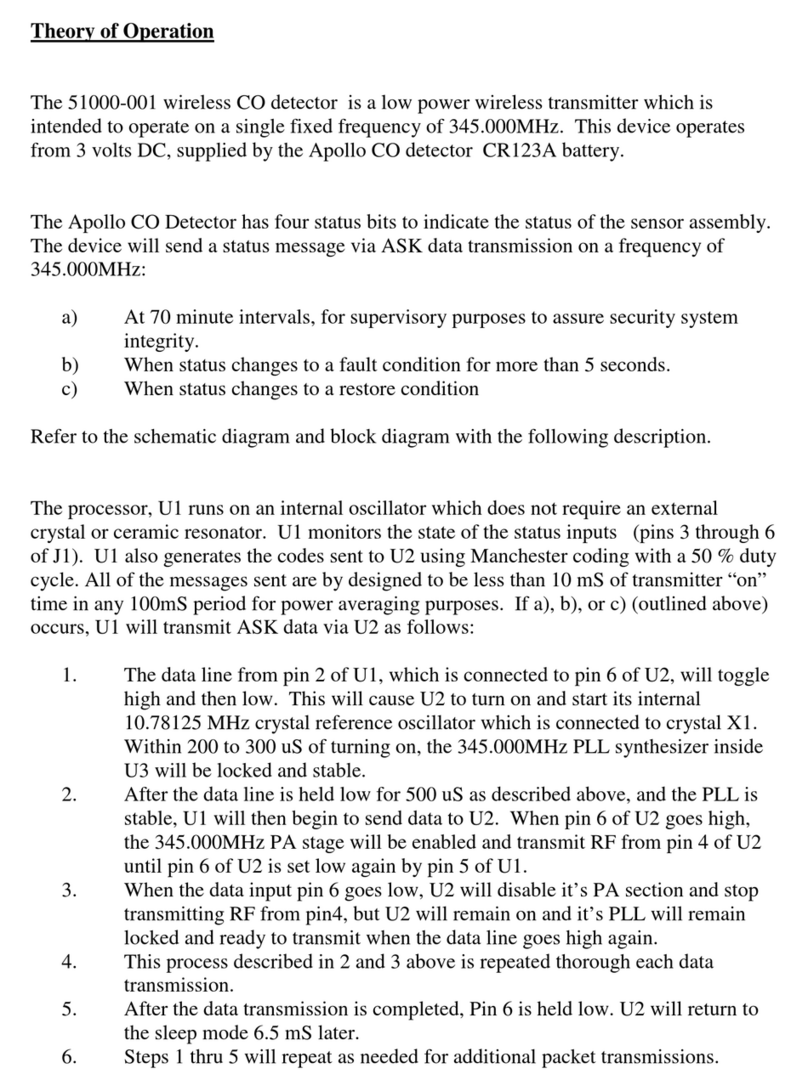
APD0671 A160301
© 2016 Apollo Fire
Figure 7. Crimping Wiretaps onto Wires
Figure 8. Wiretap Connecons
Wiring the Connections
Before connecng the wires from the interconnect base, idenfy the (+) line (hot)
120VAC wire and the neutral wire. Usually the (+) line (hot) 120VAC wire will be black
and the neutral wire white. Use a voltmeter or voltage sensor to verify that the proper
wires are selected. You may need to reconnect power to the electrical circuit powering
the interconnected hardwired smoke detectors in order to do this (Figure 8).
WARNING: Remember to disconnect or shut oelectrical power to the interconnected
hardwired smoke detector if it was powered on in the previous step to idenfy the
120VAC wires.
Use an electrician’s linesman plier or equivalent tool (See Figure 8) and using the installed
wiretaps on the device, crimp the wiretap with the black wire onto the 120VAC line
(hot) wire.
ATTENTION : Ne pas oublier de déconnecter ou couper le courant électrique pour le
détecteur de fumée câblé s’il avait été alimenté auparavant pour idener les ls 120 AC.
Uliser une pince d’électricien ou un oul équivalent (voir image 8) et en ulisant les
connecteurs installés sur l’appareil, serr le connecteur avec le l noir sur la ligne 120VAC
(posif).
✓NOTE: Wiretaps must be used on a secon of stranded wire. This is typically located
between the connector to the smoke detector and the wire nut.
The wiretap with the yellow wire should be aached to the wire lead connected to the
interconnect wire of the smoke detector. This wire is typically yellow or orange.
Once all (3) three wiretaps have been installed (Figure 8), reaach the electrical wire
pigtail to the back of the smoke detector unit and mount the smoke alarm on the
mounng base (Refer to Figure 3).
Installing the Back-Up Battery
Figure 9. Installing Back-up Baery
WARNING: Ensure that the interconnect base has been wired correctly. Damage to
the interconnect base may occur if the 120 VAC line (hot) wire neutral wire are reversed.
The unit may fail to funcon properly if incorrectly wired.
Turn on or reconnect power to the primary electrical circuit that powers the
interconnected hardwired smoke alarm system. The device should now power on.
Use a at bladed tool, slide out the baery tray that holds the backup baery. Insert
a CR2032A baery (included) into the baery slot. Slide the baery tray back into the
device (Figure 9).
ATTENTION : S’assurer que le détecteur de fumée a été branché correctement. Le capteur
du détecteur de fumée pourrait être endommagé si le l de la ligne 120AC (posif) et
le l neutre sont inversés. L’appareil pourrait ne pas fonconner correctement s’il était
mal branché. Etablir ou rétablir le courant du circuit électrique principal qui alimente
le système câblé de détecon de fumée. L’appareil devrait à présent s’allumer. Ulisant
un oul à lame plate, coulisser le roir de la pile de sécurité. Insérer une pile CR2032A
(incluse) dans l’emplacement. Coulisser à nouveau le roir pour le refermer (image 9).
✓NOTE: Orient the (+) baery terminal up so that it is visible when facing the unit.
Programming the Wireless Smoke Alarm Interconnect Base
Follow the instrucons on how to program a sensor into a compable control panel. See
the control panel’s Installaon & Programming Guide for more informaon on how to
learn a sensor into the control panel.
The device should learn in as a sensor device. Use a small paper clip or other sharp
object and carefully insert into the learn/test buon hole. This will send out an alarm
transmission ID so the the sensor can be learned into a compable control panel or can
be used to test that the transmier is working properly.
Replacing the Battery
If the compable control panel shows that this sensor has a low baery, the backup
baery may need to be replaced.
Use a at headed screw driver or other tool to slide the baery tray out of the device.
Remove the baery from the tray and replace with a new CR2032A baery. Slide the
baery tray back into the unit, making sure that the tray is fully inserted into the unit.
✓NOTE: Use Panasonic CR2032A baeries or equivalent. Use of another baery may
damage or negavely aect the operaon of the device.
End-of-Life
The Wireless Smoke Alarm Interconnect Base does not have an End-of-Life (EOL), however
the smoke alarm(s) that this device monitors may have an EOL condion. Follow the
owner's manual for the smoke alarm regarding instrucons on proper smoke alarm EOL
condions.
LED Status
Status LEDs Radio Signaling
PowerOn Sequential green, orange, red flashes N/A
Normal Green LED flash every 48s N/A
Alarm Red flash every 1s Alarm
Loss of AC Power
Fault
Orange flash every 20s Tamper
Low Battery Fault Orange flash every 4s Low Battery
Learn Button Sequential green, orange, red flashes Alarm
Testing the Smoke Alarm System
Figure 10. Locaon of LEDs and Learn/Test Buon Hole
The device should be tested in accordance with NFPA 72 guidelines. The following
instrucons are intended to provide a general guideline on how to test the smoke alarm
system, wireless smoke alarm interconnect base and communicaons to an alarm panel.
Follow the smoke alarm instrucon manual on tesng the smoke alarm and any
interconnected units. There usually is a test buon on the smoke alarm that can be
pressed to iniate a test mode. This should cause the sounder to alarm and also any
smoke alarms that are interconnected to also alarm.
The interconnect base should send out a transmission to a compable alarm panel.
If this transmission is not received, rst check if the Smoke alarm is properly programmed
into a compable alarm panel. Please follow the alarm panel instrucons on learning in
a sensor.
Also, check that the interconnect wire on the smoke alarm is properly connected to the
Wireless Smoke Alarm Interconnect Base. The LEDs on the interconnect base should
ash red indicang that it has received the alarm signal from the smoke alarm .
Testing the Wireless Smoke Alarm Interconnect Base Radio Trans-
mission Only
The Wireless Interconnect Base incorporates a small test buon. This test buon can be
acvated by inserng a straightened paper clip or sharp object into the Learn/Test hole.
The Smoke Detector Sensor will then send an alarm signal transmission to a compable
alarm panel. This can be used to test that the Wireless Smoke Alarm Interconnect Base
will send a proper transmission to an alarm panel. This DOES NOT test if the wiring
between the smoke alarm and the interconnect base is correct.
Troubleshooting Installation Chart
When tesng the Wireless Smoke Alarm Interconnect Base sensor, check for these
common issues.
Condition
Smoke Alarm
Result Resolution
Wireless Smoke Alarm
Interconnect Base LED
Alarm Panel
Smoke detector is in
alarm mode
LED on interconnect base
do not work properly
Alarm panel does not
receive alarm signals
Check to make sure
interconnect wire from
the smoke alarm is
properly connected to the
interconnect base
Smoke detector is in
alarm mode
LED on interconnect base
sensor works properly
Alarm panel does not
receive alarm signals
Check to make sure
the interconnect base
is properly learned or
programmed into a
compatible alarm panel
EXISTING
POWER
PIGTAIL
WIRETAPS (3)
CRIMPED
TO PRIMARY
CIRCUIT WIRES
WIRING CODE:
• BLACK TO BLACK (120 VAC)
• WHITE TO WHITE (NEUTRAL)
• YELLOW TO YELLOW OR
ORANGE (INTERCONNECT)
PRIMARY POWER
WIRING
WHT/WHT (NEUTRAL)
BLK/BLK (120VAC)
YEL/YEL OR
YEL/ORANGE
+
CR2032
3V
MOVETO
FRESH AIR
SMOKE
+
CR2032
3V
STEP 1
PULL OUT
BATTERY TRAY
WITH FLATHEAD
SCREWDRIVER
STEP 2
INSERT
BATTERY + POLARITY
FACING UP
WIRELESS SMOKE ALARM
INTERCONNECT BASE
SMOKE ALARM
LEDS ON WIRELESS SMOKE
ALARM INTERCONNECT BASE
LEARN/TEST BUTTON
HOLE
1. PLACE WIRE
INTO
WIRETAP.
2. HINGE WIRETAP
UP AND OVER
WIRE STRAND
3. CRIMP
WIRETAP WITH
PLIERS
WIRING CODE:
•BLACK TO BLACK (120 VAC)
•WHITE TO WHITE (NEUTRAL)
•YELLOW TO YELLOW OR
ORANGE (INTERCONNECT)
